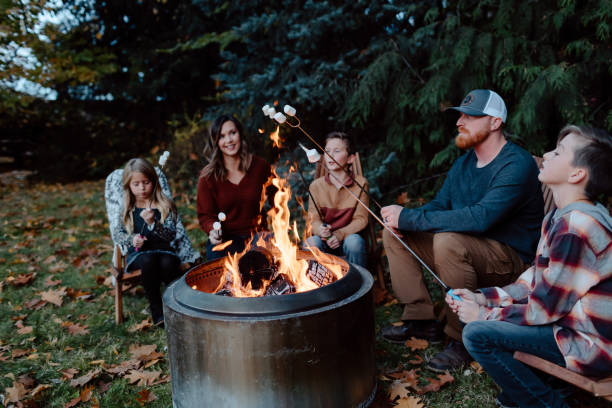Camping is an age-old tradition that has been embraced by people from all walks of life. It provides an opportunity to escape the hustle and bustle of city living and reconnect with nature. Whether you’re a seasoned camper or a novice, the camping world offers a wealth of experiences and adventures waiting to be explored.
In this comprehensive article, we’ll delve into the captivating world of camping, uncovering its rich history, the different types of camping, essential gear, and expert tips to ensure unforgettable outdoor excursions.
The History and Evolution of Camping
The Origins of Camping
- Camping has its roots in ancient civilizations, where nomadic tribes would set up temporary shelters while moving from one location to another.
- Early European exploration and the need for shelter during long journeys contributed to the development of camping as a recreational activity.
The Rise of Recreational Camping
- In the late 19th century, camping emerged as a popular leisure activity, particularly in the United States and Europe.
- The creation of national parks and the growing interest in outdoor recreation fueled the camping movement.
The Camping Renaissance
- Advances in camping gear and equipment have made camping more accessible and comfortable.
- The desire for sustainable and eco-friendly travel has led to an increased interest in camping as a low-impact way to explore nature.
Types of Camping
Tent Camping
- One of the most traditional and popular forms of camping involves setting up a portable tent in designated campsites or remote wilderness areas.
- Offers a true connection with nature and a minimalist approach to outdoor living.
RV (Recreational Vehicle) Camping
- Allows for a more comfortable and luxurious camping experience with amenities like kitchens, bathrooms, and sleeping quarters.
- Provides a home-on-wheels experience, making it ideal for families or those seeking additional conveniences.
Cabin Camping
- A blend of camping and traditional accommodation, offering basic shelter in rustic cabins or cottages within campgrounds or natural settings.
- Suitable for those seeking a balance between the outdoors and indoor comforts.
Glamping (Glamorous Camping)
- A fusion of camping and luxury, providing upscale accommodations, such as yurts, tents with proper beds, and amenities like electricity and private bathrooms.
- Appeals to those seeking a high-end camping experience without sacrificing creature comforts.

Essential Camping Gear
Tent
- The cornerstone of any camping setup, providing shelter from the elements.
- Choose a tent that suits your needs, considering factors like capacity, weight, and weather resistance.
Sleeping Bag and Pad
- A quality sleeping bag and insulating pad are crucial for a comfortable night’s sleep in the great outdoors.
- Opt for temperature-appropriate and compact options for easy packing and carrying.
Camping Stove and Cookware
- A portable camping stove and cookware set allow you to prepare hot meals and beverages during your outdoor adventures.
- Look for lightweight and efficient options that suit your camping style.
Headlamps and Lanterns
- Reliable lighting sources are essential for navigating and illuminating your campsite after dark.
- Consider headlamps for hands-free lighting and lanterns for ambient lighting in your camping area.
Navigation and Safety Gear
- Invest in a compass, map, and GPS device to ensure you can navigate your surroundings safely.
- Include essential safety items like a first-aid kit, fire starter, and whistle in your camping checklist.
Camping Tips and Tricks
Site Selection and Setup
- Choose a level, well-drained campsite away from potential hazards like dead trees or bodies of water.
- Orient your tent strategically to take advantage of natural features like shade or wind protection.
Leave No Trace Principles
- Practice responsible camping by following the Leave No Trace principles, which promote minimizing your impact on the environment.
- Pack out all trash, respect wildlife, and leave campsites as you found them.
Campfire Safety
- Adhere to local fire regulations and ensure campfires are completely extinguished before leaving the site.
- Use designated fire rings or pits, and avoid building fires in high-risk areas.
Wildlife Awareness
- Familiarize yourself with the local wildlife and take necessary precautions to avoid encounters.
- Store food properly and keep a clean campsite to deter animals from visiting.
Weather Preparedness
- Monitor weather forecasts and be prepared for changing conditions by packing appropriate clothing and gear.
- Know how to shelter in place or seek proper shelter in case of severe weather.

Camping Destinations
National Parks
- Explore the breathtaking natural wonders of national parks like Yellowstone, Yosemite, and the Grand Canyon.
- Many national parks offer designated campsites and backcountry camping opportunities.
State Parks
- Immerse yourself in the diverse landscapes and natural beauty of state parks, which often offer well-maintained campsites and recreational facilities.
Wilderness Areas
- For the adventurous, wilderness areas provide remote and untamed camping experiences, allowing you to escape the crowds and truly disconnect.
Campgrounds
- Ranging from basic to full-service, campgrounds offer amenities like showers, picnic areas, and recreation facilities, catering to various camping preferences.
Camping with Family and Friends
Bonding Experiences
- Camping fosters quality time with loved ones, creating lasting memories and strengthening family bonds.
- Engage in outdoor activities, storytelling, and shared adventures around the campfire.
Unplugged and Reconnected
- Leave behind the distractions of technology and connect and nature in a meaningful way.
- Camping provides opportunities for genuine conversations and quality interactions.
Skill Development
- Camping encourages the development of practical skills like setting up tents, starting campfires, and navigating the outdoors.
- These skills can be passed down from generation to generation, fostering a sense of independence and self-reliance.

Camping Checklist
| Category | Essential Items |
|---|---|
| Shelter | Tent, Tarp, Stakes, Hammer |
| Sleeping | Sleeping Bag, Sleeping Pad, Pillow |
| Cooking | Camping Stove, Fuel, Cookware, Utensils, Water Containers |
| Lighting | Headlamps, Lanterns, Extra Batteries |
| Navigation | Compass, Map, GPS Device |
| Safety | First-Aid Kit, Fire Starter, Whistle, Multi-tool |
| Personal Gear | Clothing, Footwear, Rain Gear, Sun Protection |
| Hygiene | Toilet Paper, Trowel, Biodegradable Soap, Towels |
| Miscellaneous | Camp Chairs, Camping Table, Games, Books, Binoculars |
FAQs About Camping World
Q: Is camping safe?
Camping is generally safe when proper precautions are taken. Follow camping guidelines, practice campfire safety, store food properly, and be aware of your surroundings. Research your camping destination and familiarize yourself with potential hazards and local regulations.
Q: What is the best time of year for camping?
The best time for camping varies depending on your location and personal preferences. Spring and fall are often ideal as temperatures are mild, and there are fewer crowds and insects. Summer can be popular but may be hot and crowded in some areas. Winter camping offers unique experiences but requires proper gear and preparation for cold weather.
Q: How do I choose a suitable camping tent?
Consider factors like the number of occupants, season, and terrain when selecting a tent. Look for a tent with adequate floor space, ventilation, and waterproofing. Evaluate the tent’s weight, ease of setup, and durability based on your camping style and needs.
Q: Is it necessary to reserve campsites in advance?
For popular camping destinations or during peak seasons, it is highly recommended to reserve campsites in advance. Many national and state parks, as well as campgrounds, offer online or phone reservations to secure your spot and avoid disappointment.
Q: What are the Leave No Trace principles?
The Leave No Trace principles are a set of guidelines designed to promote responsible and sustainable outdoor recreation. They include principles like disposing of waste properly, minimizing campfire impacts, respecting wildlife, and leaving campsites as you found them.
Q: How do I keep food safe while camping?
Proper food storage is crucial to prevent attracting wildlife and keeping your food fresh. Use bear-resistant canisters or hang food properly in designated areas. Keep a clean campsite, and dispose of food waste appropriately. Consider packing dehydrated or non-perishable foods for longer camping trips.
Q: What should I do in case of a wildlife encounter?
Remain calm and avoid surprising or approaching wildlife. Give animals plenty of space and observe them from a safe distance. Follow specific guidelines for dealing with bears, such as making noise to avoid surprising them and carrying bear spray as a deterrent.
Q: How do I stay warm and comfortable while camping?
Dress in layers to regulate your body temperature, and pack appropriate clothing for the expected weather conditions. Use a high-quality sleeping bag and insulating sleeping pad to retain warmth at night. Stay hydrated and consume warm beverages and high-energy foods to maintain body heat.
Final Words
The camping world offers a multitude of opportunities for adventure, tranquility, and personal growth. Whether you seek to reconnect with nature, bond with loved ones, or challenge yourself in the great outdoors, camping provides a unique and rewarding experience.
By embracing the principles of responsible camping and equipping yourself with the necessary knowledge and gear, you can embark on unforgettable journeys that will create lasting memories. So, pack your bags, pitch your tent, and get ready to explore the wonders of the camping world.













